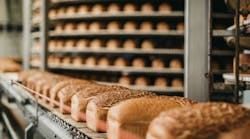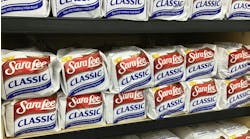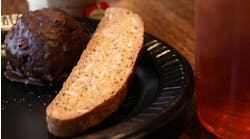When consumers think of high-quality breads and other baked goods, they think of crisp crust contrasting with airy, fluffy crumb. Or maybe nice, dense crumb with a shiny crust. All being shaped by the flour-dusted hands of a master baker.
They probably don’t think of triple-roll dough sheeters.
But the right kind of equipment and technique can help replicate many of the features associated with “artisanal” baked goods, allowing them to be mass-produced. There are kinds of equipment, even entire lines, available to turn out product that looks like it could have come from a master baker’s kitchen.
“It’s all repeatable and doable, and it can be done in automation in huge quantities,” says Gary Seiffer, a consultant and former employee of major bakery equipment manufacturers.
Arguments take place, or used to, about just how much automation could be used to make a product and still have it be called “artisanal.” Some took a hard line, Seiffer says: “There are people who said you can’t use a machine. If you use a machine, it’s not artisan.
But as companies like La Brea Bakery started pumping out high quantities of undeniably artisan-style bread, for many people that view shifted to ends instead of means. It was the process, the ingredients and, especially, the results that counted, not the equipment. It doesn’t matter how a product is processed, as long as it has the artisan-style features that consumers want.
These features, of course, vary by product. A French baguette is renowned for its crisp crust and light crumb, or interior. A bagel is boiled, which gelatinizes its crust for a shiny surface while killing yeast close to the bagel’s surface, resulting in a dense interior.
“When they first started using rack ovens for bagels and using steam injection, [critics said] that’s not a bagel, it’s a roll with a hole in the middle, because it was growing too fast,” Seiffer says.
The key, he says, is to respect the traditions of whatever product is being made – up to a point. There’s no one rule, even within narrow, established product categories.
“A French baguette to some people has sort of a medium cell structure, but in other regions of France, they say, well, it’s got to be a little bit more airy,” Seiffer says.
Be gentle
Despite all the possible product variation, mass production of artisanal-style bread does have certain principles that apply generally. Perhaps the most common is gentle handling.
One aspect many artisanal breads have in common is a relatively open cell structure for the crumb, which gives it a pleasing, fluffy texture. This is a function of the amount of carbon dioxide trapped inside the dough. To keep that carbon dioxide where it belongs, it’s important not to put too much stress on the dough. That means paying attention to the beginning of the line, where most of the stress occurs, says Ken Hagedorn, vice president of sales for Naegele Inc.
“If you do any damage in the front part of the line by feeding that dough, there’s nothing you’re really going to do downstream that’s going to correct the damage,” Hagedorn says. The key, he says, is to avoid, as much as possible, letting it degas by breaking the dough’s “skin.” This is especially challenging for dough that is allowed to ferment a long time. Fermentation often makes the dough take on water, leaving it with up to 90% water in some cases.
This pilot plant at Rheon USA’s headquarters features examples of an artisanal bread line. Photo: Rheon
Gentle handling starts with literally the first step: loading dough into the hoppers that feed the processing lines. It’s important that those hoppers aren't too big, says John Giacoio, vice president of sales for Rheon USA. Industrial baking lines often start with dough hoppers that hold a thousand pounds or more, but with dough rich in carbon dioxide, a quantity that massive would crush the gas out of the dough at the bottom. Giacoio says this principle sometimes doesn’t register with bakers who come to Rheon’s pilot facilities and get a look at its model artisan bread line.
“They look at our hoppers at the head of the line and they say, ‘Why are they so small? I need to get a thousand, two thousand pounds of dough into that hopper,’” he says. But in most cases, they come around.
“Once we explain to them and show them how it works, they’re like, ‘Wow, it really makes sense. Why would you let the dough sit around for two or three hours to develop a cell structure and then crush it on itself?’”
Lightening up
Cutting back the amount of dough that can be fed to the line often takes considerable adjustment. It’s probably easiest for products where the dough has a high water content, like ciabatta, which can be 80% or more water.
That kind of dough actually flows, so thousands of pounds can literally be poured onto the conveyor belt. But the hoppers still have to be kept small and fed continuously, because crushing the carbon dioxide out of the dough is still possible if too much accumulates.
Equipment like this dough divider is available in stress-free version that will not degas dough rich in carbon dioxide. Photo: Rheon
With dough that doesn’t flow, there’s little alternative to letting it sit -- in a mixing bowl, a dough box or another container -- until it’s ready to go through the downsized hoppers. That means it has to have room. “The smaller a customer is willing to go, the better for the end product, but that means they’re going to need more floor space to take that time on the dough,” Giacoio says.
In any case, many artisanal products require the dough to proof or rest for hours, which requires space. As Giacoio points out, if a two-ton line is being fed in 500-lb. batches and the dough has to rest for three hours, that’s 24 bowls of dough that are going to be sitting on the floor at any given time.
“There are shortcuts you can take, but you can see it in the end product,” Giacoio says.
Forming the batch of dough into individual loaves, rolls or whatever is the next step, where gentle handling is crucial. Some conventional ways of dividing dough, like three-roll sheet extruders or dough ball extruders, apply too much pressure to be suitable for many artisanal products.
“If you had a very gassy dough and you ran it through a normal three-roll extruder, you’re basically going to degas it and destroy it,” Hagedorn says. “There’s nothing you can do further down the line that’s going to help you.”
That’s why stress-free equipment, or entire lines, are available from Rheon and other suppliers. Conventional sheeters use compression rollers that force dough through a fixed opening. In Rheon’s stress-free line, rollers underneath the dough, at the conveyor belt, move at different speeds, allowing the dough to advance with less stress.
“So there’s not really compression,” Giacoio says. “It’s more pulling the dough from the ends to reduce the dough thickness. We try to get away from compression at all costs.”
For products that require even gentler handling, like filled puff pastry, Rheon offers a more sophisticated reduction system: rollers that move in an elliptical path above the dough, holding it against three different conveyor belts, each of which moves faster in succession. This stretches the dough without compressing, so that the layers of fat and dough are undisturbed.
Steam and crusts
Of course, what happens in the oven is as important as what happens before the oven. One of the standard practices for many artisanal breads, especially those with crisp crusts, is to ensure that the oven has adequate steam.
When starch in the dough mixes with steam, it becomes gelatinous, preventing the crust from getting too hard too fast, Seiffer says. Once that gelatinous structure starts to bake out and become dry, the crust gets hard to just the right degree.
“So if you put a dough into an oven without steam, there’s a good chance it’s going to become too dense too quickly, or too baked in the crust too quickly, and then the bread itself becomes dense, because it can’t grow,” Seiffer says.
The type of heat is also important. The basic choice is between direct fire and alternatives like indirect fire, usually done with heat exchangers, or impingement with hot air.
The source of heat usually is determined by considerations like how fast the dough has to set up and how much moisture is required. For pan breads, where the moisture is usually retained by the pan, indirect fire is often used. If a bread needs to have moisture pulled away during baking, an alternative is hearth-firing, where the dough rests on a stationary stone or moving stone belt.
For products that need a gentle bake, thermal-oil ovens are an option. These are popular in Europe and are beginning to become so in the U.S., Hagedorn says. Coils or plates heated by the oil are positioned above the product and/or below the conveyor belt. It provides gentle heating but is relatively expensive and not as easy to use as alternatives, he says.
Whether it’s a crisp crust, an airy interior, a dense one, or whatever makes bread and other goods seem “artisanal,” it can usually be done in whatever quantity is needed – with the right equipment, technique and, especially, enough time.


